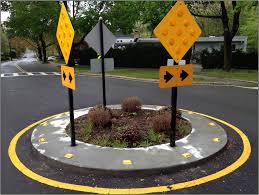Town Council Advised to Remove Mini-Roundabouts in Echo Hill

Mini-roundabouts such as this one were installed in the summer of 2024 on Heatherstone Road. Photo: National Association of City Transportation Officials / amherstma.gov
The Town Services and Outreach Committee (TSO) adopted a resolution at their meeting on July 17, to recommend to the Town Council that the mini-roundabouts installed on Heatherstone Road in the summer of 2024 as a traffic calming measure be removed.
Although Amherst police report that the roundabouts have reduced speeding, residents have reported that the roundabouts have created new safety hazards.
The TSO began a discussion of the roundabouts at their June 26 meeting and initially leaned toward not recommending any changes to the existing situation. But after receiving substantial critical testimony from the public, TSO voted unanimously (5-0) on July 17 to recommend removing the roundabouts.
At the August 7 meeting, TSO chair Andy Steinberg asked the committee to revisit their recommendation to the council, arguing that removing the roundabouts, without having a plan in place to introduce alternative traffic-calming measures, would pose a greater safety hazard.
After considerable discussion, the committee reached a consensus that their original recommendation to the Town Council would stand, and that should the council concur, it would be up to them to determine the timing of the removals.
The Discussion
Steinberg asked the committee to reconsider its recommendation, stating that removing the roundabouts without having a plan for an alternative traffic-calming measure in place, would increase the hazard on that road.
Town Councilor Jennifer Taub (District 4) said she had assumed that the committee had decided that the mini-roundabouts were going to be removed and that they would not remain in place until some other traffic calming measures can be implemented. She worried that developing a plan for alternative traffic calming measures would likely take a long time and suggested that if the roundabouts are left in place, there will be less incentive to seek and implement that alternative. She emphasized that the overwhelming majority of feedback the town has received deem the mini-roundabouts to be a hazard and favors their removal.
Steinberg noted that the town had heard from two different groups
- people who feel the roundabouts have served the purpose of traffic calming and who appreciate their efficacy
- people who believe that the roundabouts pose a number of problems, and are a greater safety hazard, and should be removed
Steinberg noted that there are a lot of children in the area, there is a lot of pedestrian traffic in the streets, and speeding has been deemed a persistent problem on that road. He said, “There are real risks of creating a dangerous situation without some traffic calming in place.” He said that he is disappointed that the roundabouts have not worked out,“but we need to consider how we will ensure safety before we remove them.”
Taub countered that the town has heard from far more people who feel that the roundabouts are a hazard and said she fears that the town will not come up with an alternative if we leave them in place. “Things move slowly when we have a plan — and without a plan nothing happens,” she said.
Councilor George Ryan (District 3) said, “ We’ve heard from a fair number of residents who believe that this is a hazard. People don’t understand how to use them, they drive the wrong way around them, they veer off the road, they drive over them. Some residents insist that speeding continues while police say it is reduced. The bottom line is if we don’t remove them they are going to stay there for quite a while.”
Taub noted that TSO voted to recommend that they should come down but did not recommend when.
Councilor Hala Lord (District 3) believed that they need to come down sooner rather than later.
Steinberg lamented that Superintendent of Public Works Guildford Mooring was not present to weigh in on time and cost issues.
The committee agreed that the recommendation to remove the roundabouts will stand and that it is up to the council to determine whether any contingencies apply.
Taub was concerned that the draft report to the council, authored by Steinberg, does not convey the strong opposition to roundabouts. “The vast majority who we have heard from oppose them,” she pointed out. “This needs to come through in the report so the council understands why we made the recommendations.”
Steinberg disagreed, but indicated that he would revise his report and run it by the committee before it goes to council.
